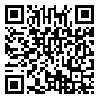Volume 10, Issue 2 (Summer 2023)
johe 2023, 10(2): 107-114 |
Back to browse issues page
Research code: 14073
Ethics code: IR.MAZUMS.REC.1401.14073
Download citation:
BibTeX | RIS | EndNote | Medlars | ProCite | Reference Manager | RefWorks
Send citation to:



BibTeX | RIS | EndNote | Medlars | ProCite | Reference Manager | RefWorks
Send citation to:
Mahmoodi M H, Kalteh H O, Etemadi Nezhad S, Hossein Nataj A, Samaei S E. Assessment of Work Ability Status and Its Association with Fatigue and Health among Industrial Workers in Southeast Iran. johe 2023; 10 (2) : 5
URL: http://johe.umsha.ac.ir/article-1-863-en.html
URL: http://johe.umsha.ac.ir/article-1-863-en.html
Mohammad Hosein Mahmoodi1 

 , Haji Omid Kalteh *2
, Haji Omid Kalteh *2 

 , Siavash Etemadi Nezhad1
, Siavash Etemadi Nezhad1 

 , Abolfazl Hossein Nataj3
, Abolfazl Hossein Nataj3 

 , Seyed Ehsan Samaei1
, Seyed Ehsan Samaei1 




 , Haji Omid Kalteh *2
, Haji Omid Kalteh *2 

 , Siavash Etemadi Nezhad1
, Siavash Etemadi Nezhad1 

 , Abolfazl Hossein Nataj3
, Abolfazl Hossein Nataj3 

 , Seyed Ehsan Samaei1
, Seyed Ehsan Samaei1 


1- Department of Occupational Health Engineering, Faculty of Public Health, Mazandaran University of Medical Science, Sari, Iran
2- Department of Occupational Health Engineering, Faculty of Public Health, Mazandaran University of Medical Science, Sari, Iran ,h.omid@mazums.ac.ir
3- Department of Biostatistics and Epidemiology, Faculty of Public Health, Mazandaran University of Medical Science, Sari, Iran
2- Department of Occupational Health Engineering, Faculty of Public Health, Mazandaran University of Medical Science, Sari, Iran ,
3- Department of Biostatistics and Epidemiology, Faculty of Public Health, Mazandaran University of Medical Science, Sari, Iran
Abstract: (2982 Views)
Background and Objective: Workforce aging is one of the problems leading to a decrease in working ability. This study aimed to evaluate the perceived work ability and its association with fatigue, as well as general and mental health in industrial workers.
Materials and Methods: A total of 350 people working in various industries of Zahedan, Iran, participated in this cross-sectional study. The data were collected using the first item of the work ability index questionnaire known as work ability score (WAS), the fatigue assessment scale, as well as the general and mental health scales of the Copenhagen questionnaire. The Pearson correlation and multiple linear regression were used to analyze the data. The data were analyzed using SPSS software (version 24).
Results: The mean score of the WAS among the studied subjects was 4.76±1.59, which is categorized as a poor level. According to the results of multiple linear regression analysis, fatigue, general health, and mental health had a significant effect on perceived work ability, among which the strongest relationship was related to fatigue (β=-0.324; P<0.001). The results of the study did not show a relationship between body mass index and perceived work ability (β=-0.021; P<0.05).
Conclusion: According to the findings of the research, the perceived work ability was at a poor level. Fatigue and general health had the greatest effect on perceived work ability. It is suggested to design and implement studies in order to identify other factors affecting work ability.
Materials and Methods: A total of 350 people working in various industries of Zahedan, Iran, participated in this cross-sectional study. The data were collected using the first item of the work ability index questionnaire known as work ability score (WAS), the fatigue assessment scale, as well as the general and mental health scales of the Copenhagen questionnaire. The Pearson correlation and multiple linear regression were used to analyze the data. The data were analyzed using SPSS software (version 24).
Results: The mean score of the WAS among the studied subjects was 4.76±1.59, which is categorized as a poor level. According to the results of multiple linear regression analysis, fatigue, general health, and mental health had a significant effect on perceived work ability, among which the strongest relationship was related to fatigue (β=-0.324; P<0.001). The results of the study did not show a relationship between body mass index and perceived work ability (β=-0.021; P<0.05).
Conclusion: According to the findings of the research, the perceived work ability was at a poor level. Fatigue and general health had the greatest effect on perceived work ability. It is suggested to design and implement studies in order to identify other factors affecting work ability.
Article number: 5
Type of Study: Research Article |
Subject:
Ergonomics
Send email to the article author
| Rights and permissions | |
 |
This work is licensed under a Creative Commons Attribution-NonCommercial 4.0 International License. |




